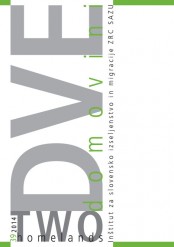Linguistic Mobility in the Central European Periphery and Multiethnic Heritage at the Beginning of the 20th Century
Keywords:
interculturalism, multiculturalism, multilingualism, food, recipes, household, Prekmurje, borderAbstract
By analyzing language use related to food, the author attempts to demonstrate that despite the allencompassing nationalist identity, the people living in Central European border areas in the late nineteenth and early twentieth century still shared in their everyday lives the same transnational rhetoric for both self-identification and recognition of others. Using a manuscript collection of recipes and other household instructions for housewives, where two and sometimes even three languages are used in a single paragraph, the author argues that this multicultural way of remembering and sharing professional expertise was the usual practice of everyday communication until the end of the Second World War, when the creation of socialist Yugoslavia led to the formation of three newly politicized nationalities/ ethnicities, two religious identities and (after 1945) one exclusive ideology that produced a new set of practices of cohabitation and differentiation.
Downloads
References
Brumen, Borut (1995). Na robu zgodovine in spomina. Urbana kultura Murske Sobote med letoma 1919 in 1941. Murska Sobota: Pomurska založba.
Cole, Laurence, Unovsky, Daniel (2007). The Limits of Loyalty. Imperial Symbolism, Popular Allegiance, and State Patriotism in the Late Habsburg Monarchy. New York, Oxford: Berghahm Books.
Freedman, Paul (2012). The Circulation of Food. The Medieval Spice Trade. The Oxford Handbook of Food History (ed. Jeffrey Pilcher M.). Oxford: Oxford University Press.
Haberl Zemljič, Andrea (2012). Pustiti jezik v vasi. Ohranjanje in opuščanje slovenskega jezika v Radgonskem kotu. Ljubljana: Inštitut za narodnostna vprašanja, Ustanova dr. Šiftarjeva fundacija.
Harvey, Karen (2009). History and Material Culture. A Student’s Guide to Approaching Alternative Sources. London: Routledge.
Ilešič, Svetozar (1959). Pregled razvoja Murske Sobote. Geografski zbornik. Murska Sobota.
Kranjec, Miško (1967). Rdeči gardist III. Murska Sobota: Pomurska založba.
Kokolj, Miroslav (1957). Prekmurje v prevratni dobi. Svet ob Muri. Murska Sobota.
Marranca, Bonnie (ed.) (2003). A Slice of Life. New York: Overlook Duckworth.
Gräfin Schönfeldt, Sybil (2004). “Feine Leute kommen spät ...” oder Bei Thomas Mann zu Tisch. Tafelfreuden im Lübecker Buddenbrookhaus. Zürich, Hamburg: Arche.
Slavič, Matija (1921). Prekmurje. Ljubljana.
Slavič, Matija (1935). Prekmurske meje v diplomaciji (ed. Vilko Novak). Slovenska knjiga: Beltinci.
Teply, Bogo (1970). Spomini na Soboto in njeno gimnazijo (1926–1928). Petdeset let gimnazije v Murski Soboti. Murska Sobota.
Tucker, Susan ed. (2009). Setting the table in New Orleans. New Orleans Cuisine: Fourteen Signature Dishes and Their Histories. Jackson: University Press of Mississippi.
Zelko, Ivan (1962). Murska Sobota. Kronika X/1. Ljubljana.
Zorn, Tone (19849. Iz šolske problematike v Prekmurju po priključitvi k Jugoslaviji v letih 1919–1922. Časopis za zgodovino in narodopisje 55/1. Maribor.
Downloads
Published
How to Cite
Issue
Section
License

This work is licensed under a Creative Commons Attribution-NonCommercial-NoDerivatives 4.0 International License.
Authors guarantee that the work is their own original creation and does not infringe any statutory or common-law copyright or any proprietary right of any third party. In case of claims by third parties, authors commit their self to defend the interests of the publisher, and shall cover any potential costs.
More in: Submission chapter





